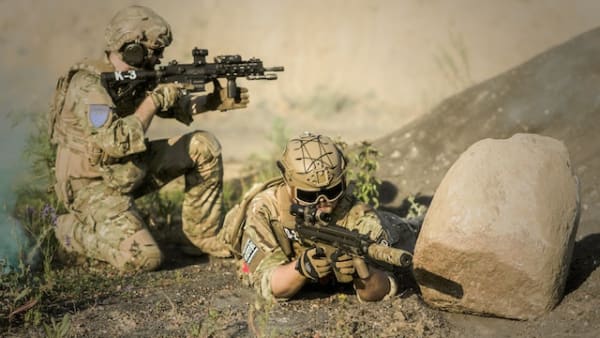What is the British Army Orientation test?
The orientation test is a section of the British Army Cognitive Test that every potential soldier has to take to decide what roles would be most suitable for their inherent skills and abilities.
In the orientation section, candidates are being assessed on their spatial awareness and memory which are important abilities in the Army.
Good performance in the orientation test and the wider ACT will open up opportunities for a wide range of roles and help recruits make a decision on where they would like to specialise in their career.
The format of the British Army orientation test
The orientation test consists of a number of questions, and each question is in two stages.
In the first stage of a question, you will be given a set of two specific rules about the colour and direction of a pair of arrows. They will usually describe both colour and direction in relation to one another.
Candidates will need to memorise these rules before moving on to the next page, to select the arrow combination that matches the information given on the previous page. Candidates cannot go back and reread these rules so it is important that they are correctly memorised.
This part of the test is marked on both accuracy of answers and speed of reading the questions, so it is important to be both quick and correct to get the maximum score.
How is the British Army orientation test scored?
The orientation section of the ACT is scored alongside the other segments to give an overall score. Points are allocated for accuracy and speed - so the faster a candidate answers correctly, the higher a score will be given.
At the end of the ACT, recruits are presented with a General Trainability Index (GTI) score. This is the result that determines which army roles would be most appropriate for your natural abilities. A score of 26 or higher is usually needed to pass, but the higher the score, the more opportunities will be presented. Usually, a score of 60 is the highest result needed for most career paths.
Performance on the ACT is just one facet of the recruitment process; there are other assessments that will need to be completed at the assessment centre including a fitness test and a medical before you have a career conversation with your Candidate Support Manager about your next steps.
How to pass the British Army orientation test
As the ACT orientation test is assessing your spatial awareness and your memory, practice will make you feel more confident. You can take a practice orientation test with the Army test publisher Mindmill which will show you exactly what the assessment itself will look like - so not only can you get a feel for the type of questions you will be asked, you can also experience the format too.
If you want to practice your general spatial awareness skills, you can find a number of resources online that let you practice under assessment conditions. This is beneficial even if they are not necessarily the same as the test you will be taking as they allow you to hone your skills in imagining and manipulating shapes.
Before the assessment centre, be sure that you get adequate rest and you have eaten well and have plenty to drink so that you can perform at your best. Remember that your ACT score will determine the roles that you are most suited for - so the better the score, the wider your choices will be in your future career. Throughout the process, your Candidate Support Manager will be able to help with any questions that you might have.
Check out our full British Army ACT aptitude tests page here that include free tests.





